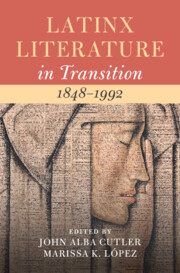Book contents
- Latinx Literature in Transition, 1848–1992
- Latinx literature in transition
- Latinx Literature in Transition, 1848–1992
- Copyright page
- Dedication
- Contents
- Figures
- Contributors
- Acknowledgments
- Introduction
- Part I Space
- Part II Being
- Part III Time
- Part IV Form
- Part V Labor
- Chapter 17 Seeking Parteras in the Archive
- Chapter 18 The Work of War
- Chapter 19 Farmworker Culture in Literature and Film, or Tomás Rivera’s Brown Noir
- Chapter 20 The Specter of Neoliberalism
- Bibliography
- Index
- References
Chapter 17 - Seeking Parteras in the Archive
Latinx Literature in Transition and the Labor of Labor
from Part V - Labor
Published online by Cambridge University Press: 10 April 2025
- Latinx Literature in Transition, 1848–1992
- Latinx literature in transition
- Latinx Literature in Transition, 1848–1992
- Copyright page
- Dedication
- Contents
- Figures
- Contributors
- Acknowledgments
- Introduction
- Part I Space
- Part II Being
- Part III Time
- Part IV Form
- Part V Labor
- Chapter 17 Seeking Parteras in the Archive
- Chapter 18 The Work of War
- Chapter 19 Farmworker Culture in Literature and Film, or Tomás Rivera’s Brown Noir
- Chapter 20 The Specter of Neoliberalism
- Bibliography
- Index
- References
Summary
Harkening to parteras’ voices prompts us to reposition ourselves in relation to literature and literary history by looking to the non-literary, the silences, and the interstices of print culture: court documents, folklore, testimonio, peripheral material within Spanish-language newspapers, second- and third-hand accounts, a birth story told year after year but never written down. In this way, the literature of parteras – and Latinx literature in transition more broadly – reflects the betweenness that would come to be theorized in the late twentieth century by Chicana feminists and Latinx literary recovery projects. Parteras, in their role, are not the ones being born nor the ones giving birth; they guide birth, counseling, positioning, and attending to labor. So, too, can their archival traces attend to the transition of Latinx literature into new forms and new consciousnesses.
- Type
- Chapter
- Information
- Latinx Literature in Transition, 1848–1992 , pp. 297 - 314Publisher: Cambridge University PressPrint publication year: 2025

